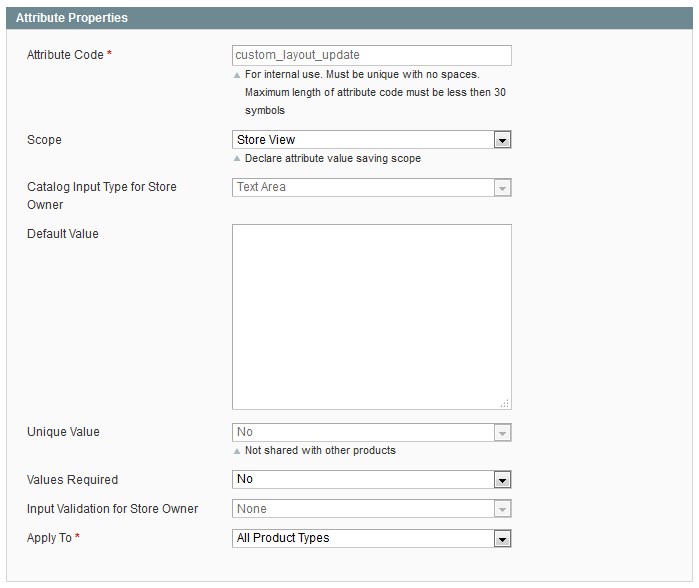Here you can find the instructions on how to create an attribute and apply it to the products.
Magento uses attributes to manage the information about the products. You could see attributes fields in forms, reports, product reviews, layered navigation, and email messages. The product attributes include: size, brand, color, SKU, etc. Some attributes are default (Default or system attributes), and others can be created specifically to your needs (Custom attributes). The attributes can be grouped into attribute sets.
- Default or system attributes – these attributes can never be deleted. The default attributes are name, price, URL, SKU, descriptions, images, etc. To see the list of default attributes, go to the Catalog > Attributes > Manage Attributes section in your Magento store admin panel.
- Custom attributes – create the attribute for the specific products. E.g. Imagine you have a jewelry shop and you need to show customers the stone capacity. So, you need to add the product attribute called Stone Capacity. After that you can set the Stone Capacity value when configuring/creating the product.
Add an attribute
Go to the Catalog > Attributes > Manage Attributes section.

Then click on the Add New Attribute button.

Properties tab
Go to the Properties tab. There you will see the following Attribute Properties:

- Attribute Code — set the name of the attribute which will be used by the system. E.g. material, color, weight.
- Catalog Input Type for Store Owner — describes what kind of data the attribute will store.
- Unique Value — select “yes” if you want the data saved in this attribute to be unique for each product.
- Values Required — select “yes” if you want the value be requited for each product.
- Input Validation for Store Owner — decides whether the data entered by the store owner is validated when the product is saved.
- Apply To— determines for which product type this attribute will be displayed.
You can see the next Frontend Properties:

- Use in quick/advanced search — if “yes”, the data saved in this attribute will be searchable in the front-end in the quick search and advanced search.
- Comparable on Front-end — if “yes”, this attribute will be displayed in a product comparison, if as at least one product in the Compare List contains a value for this attribute.
- Use in Layered Navigation — can be used only with catalog input type Dropdown, Multiple Select and Price.
- Position — determines the position of this attribute in the Layered Nav menu.
- Visible on Catalog Pages on Front-end: — if “no”, this attribute will not be displayed in the product info page. The “visibility” only controls whether or not the attribute displays in the front-end. Keep in mind – if you set an attribute to “Visible: No”, and leave it as “Comparable: Yes”, this attribute will still show up in comparison charts.
Label/Options tab
Enter the attribute label which will be visible on the front-end. If a store’s label is blank, this store will look to the default label and use this one. The Manage Options (values of your attribute) option allows to enter the values names and titles (e.g. lycra, nylon, polyester, satin, lace, silk). Click Add Option each time you need a new line of fields for the attribute values.

Then click Save Attribute.
Apply the attribute to a product
- In order to apply the attribute to a product, you need to add the one to an attribute set. In order to do this, go back to the Catalog > Manage Attribute Sets section.

- Click on the Add New Set button.
- Give your new attribute set a name by entering the Name filed. E.g. material. Let it be Based On > Default. Then click Save Attribute Set.

- You will see the attribute set you’ve just created in the third column labeled Unassigned Attributes. All you need is to move it to one of the groups in the second column.

- Finally, click on the Save Attribute Set button.











